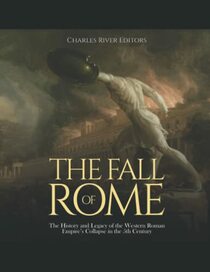The sack of Rome was caused by Roman arrogance and their blind disregard for the changes occurring in the world. The end of Rome was the culmination of centuries of internal turmoil and ignored external threats. After the five good emperors of Rome, things gradually devolved. Without a strong leader, decay set in and dominated the city. Rome had over a million citizens at one time; by the end, there were barely 30,000.
There was no system of orderly succession in the empire. As more immigrants joined the military ranks, they were devoted to their leaders, not the empire. Before long, the military could be bought instead of standing firm for the empire. Emperors came and went with fantastic regularity. This caused upheaval. Instead of protecting the cities and borders of the empire, troops were used for internal fighting to place their emperor on the throne. This caused the cities to change into walled, self-contained communities, prepared to protect themselves (instead of relying on troops).
Besides the internal and external strife, the Antonine Plague and the Plague of Cyprian decimated the populations. On top of that, there were 26 claimants to the throne in 50 years. Before long, the military was determining who would be the next emperor, not the Senate. Constantine decided to create a new capital in Byzantium. He siphoned much of the Roman Empire's wealth and left Rome's dying carcass behind.
Rome was ready for plucking, and the German tribes rushed to topple the city. With not enough troops and poor leadership, Rome fell. This was so tremendous that St. Augustine and Jerome wrote about the shock of it all. In a short time, the Western Empire was devolving into separate states.
On page 77, the author provides a valuable map of the Gothic tribes' control of Europe. This author is also knowledgeable about Ravenna and its fascinating ancient history. There's so much more to Ravenna's history than most folks are aware of, and this author explains it well. I would have liked to have had more photos of the magnificent churches. The final pages outlined the fall of Constantinople in 1453 CE, which would change it to an Ottoman possession.
There was no system of orderly succession in the empire. As more immigrants joined the military ranks, they were devoted to their leaders, not the empire. Before long, the military could be bought instead of standing firm for the empire. Emperors came and went with fantastic regularity. This caused upheaval. Instead of protecting the cities and borders of the empire, troops were used for internal fighting to place their emperor on the throne. This caused the cities to change into walled, self-contained communities, prepared to protect themselves (instead of relying on troops).
Besides the internal and external strife, the Antonine Plague and the Plague of Cyprian decimated the populations. On top of that, there were 26 claimants to the throne in 50 years. Before long, the military was determining who would be the next emperor, not the Senate. Constantine decided to create a new capital in Byzantium. He siphoned much of the Roman Empire's wealth and left Rome's dying carcass behind.
Rome was ready for plucking, and the German tribes rushed to topple the city. With not enough troops and poor leadership, Rome fell. This was so tremendous that St. Augustine and Jerome wrote about the shock of it all. In a short time, the Western Empire was devolving into separate states.
On page 77, the author provides a valuable map of the Gothic tribes' control of Europe. This author is also knowledgeable about Ravenna and its fascinating ancient history. There's so much more to Ravenna's history than most folks are aware of, and this author explains it well. I would have liked to have had more photos of the magnificent churches. The final pages outlined the fall of Constantinople in 1453 CE, which would change it to an Ottoman possession.




